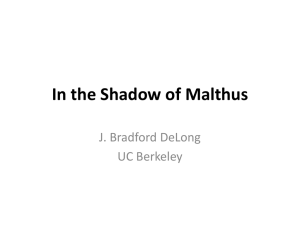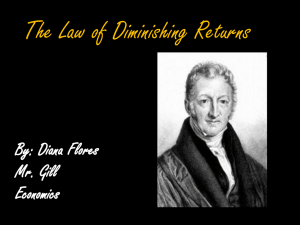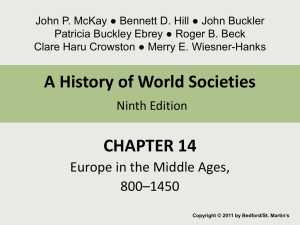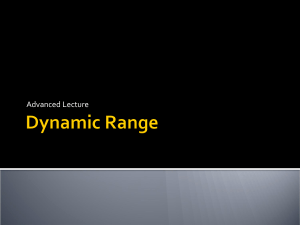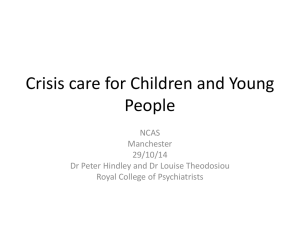II. MACRO- AND STRUCTURAL CHANGES IN THE EUROPEAN
advertisement
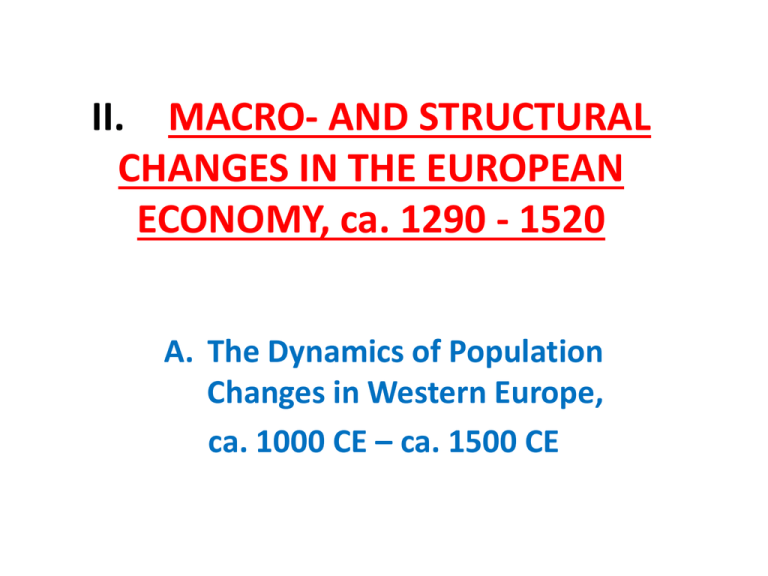
II. MACRO- AND STRUCTURAL CHANGES IN THE EUROPEAN ECONOMY, ca. 1290 - 1520 A. The Dynamics of Population Changes in Western Europe, ca. 1000 CE – ca. 1500 CE Demography and Macro-Economics • (1) Robert Lopez: ‘Population and Prices are the twin pillars of economic history’ • (2) Our examination of macro-economic changes in both semesters necessarily involves three components: • POPULATION, • MONEY, AND • PRICES Prices in Medieval Europe • (3) Price Changes: in terms of • a) monetary factors: stocks and flows of money on the form of coin and also credit • b) real factors: demography, technology, overseas explorations, settlements, etc. • (4) Distinction between NOMINAL and REAL PRICES or RELATIVE PRICES: i.e., the price of one good relative to prices of other good Prices: Nominal and Real 1 • (1) Nominal Prices and the Price Level • a) prices indicated in nominal money of account: in modern terms: in current dollars (or pounds) • b) prices measured in terms of the Consumer Price Index, in index numbers: Composite Price Index • (here: with a base period of 1451-75 = 100) • c) Movement of Nominal Prices and Nominal Wages: in terms of INFLATION & DEFLATION, also expressed in index numbers Prices: Nominal and Real 2 • (2) Real or Relative Prices and Wages • (a) REAL PRICES: price changes of Good X (wheat) relative to changes in the price of Good Y (bricks): • b) or relative to changes in the CPI deflated prices • c) REAL WAGES: Nominal Wage Index divided by the Consumer Price Index: • RWI = NWI/CPI, expressing what the nominal money wage in silver would buy in good & services The Phelps Brown CPI and Real Wages in England, 1264-1954 English Price Indexes: 1266-1520 English Prices: 1501 - 1770 Changing Population of Medieval and Early Modern Europe • What do we know about levels of population and change in population in medieval and early modern Europe? • Before 1600, we can deal only with estimates • The following are the best that we have • We next want to relate these changes in population to changes in the price levels, and to changes in economic growth (or contraction) Population Movements in Europe, 1000 - 1800 Year Population in Millions 1000 40 million 1150 60 – 70 1300 80 - 100 1350 75 – 90 1400 52 – 60 1450 50 1500 61 1550 69 1600 78 1650 74 1700 84 1750 97 1800 122 Population Graph: 1300 - 1800 England’s Population 1541 - 1741 Demography & the Economy 1 • Population Growth or Decline affects both: • a) aggregate demand: in terms of total factor incomes in society – but that depends on • i) percentage of adult population with means of payment: for monetized aggregate demand • ii) age structure (pyramid) of the population: ratio between producers (adults) and consumers • b) aggregate supply: in terms of the factors of production, three of which grow or contract with population changes Demography and the Economy 2 • The Fundamental Questions to be asked: • 1) What were the causes of population growth? • a) as the consequence of economic growth? • -- thus endogenous factors: built into the economy • b) or: consequences of independent variables, especially biological: e.g., pathogens & diseases, as exogenous factors Demography & the Economy 3 • 2) What were the consequences of population growth: positive or negative? • a) was economic growth itself generally the positive consequence of population growth? • b) or did population growth (at times) lead to subsistence crises, economic crises, and demographic crises? • c) For subsistence crises, we must now turn to the famous Law of Diminishing Returns, in terms of the basic factors of production (as follows). Population, Wages, Prices in England, 1541 – 1913 (Lindert) RWI = NWI/CPI Factors of Production, Diminishing Returns, and Population Factor of Production Factor Cost or Factor Income LAND RENT LABOUR WAGES CAPITAL INTEREST ENTERPRISE PROFIT SUM (∑) OF FACTORS = TOTAL COSTS = TOTAL INCOME = NNI Law of Diminishing Returns: with population growth Classical Economists on Population Growth • (1) Robert Thomas Malthus (1766-1834): Essay on the Principle of Population (1798) • a) that population tends to grow exponentially (geometrically) – If left unchecked • b) but output – food supply – grows, at best, only arithmetically • (2) David Ricardo (1772 – 1823) • - Theory of ECONOMIC RENT: role of population growth in determining grains prices determining land rents and real incomes Malthus & Malthusians • (1) Malthus did not believe that population would continue to grow unchecked: because of • - Providential or Positive Checks: war, famine, disease, etc. (Four Horsemen of Apocalypse) • - Prudential or Preventive Checks: the European Marriage Pattern in controlling fertility (next day) • (2) But most economic historians have adopted a pessimistic Malthusian view: that population growth ultimately halted economic growth • – until the Industrial Revolution broke that barrier (from about the 1820s – not before) Causes of Demographic Changes • (1) Endogenous Factors: working within the economy as a whole • - thus the Malthusian model: population growth → falling real wages & real incomes • - subsistence crises → demographic crises (as in the Lindert graph) • (2) Exogenous Factors: from the outside: Providential checks of war, famine, disease Diminishing Returns and the Malthusian Problem: I • 1) The Law of Eventually Diminishing Returns is the proper, correct way of viewing this economic axiom • 2) Consequences of population growth: depend on whether the economy, at the outset of the case study: • - is underpopulated or overpopulated • - in terms of available, land, capital, technology, • 3) When underpopulated, additions of labour to fixed stocks of K (land and capital) led to increasing marginal productivity • - because labour can be used more efficiently • - through specialization of labour tasks Diminishing Returns and the Malthusian Problem: II • 4) Diminishing returns set in ONLY AFTER population growth has reached its economically feasible maximum • - even so, note that the marginal product curve descends before the average product curve reaches it maximum output • 5) Subsistence crises will occur only after the average product curve descends further – and crosses the subsistence level (however defined) • 6) Technological changes + additions of new land and capital will check, postpone any such crises Population growth and the agrarian economy • Suppositions: in following model • 1) Agricultural economy is one of Mixed Husbandry using both PASTURE for livestock and ARABLE for grain & other crops • 2) More calories per acre - produced from crops (arable) than from livestock (pasture): about 4:1 • 3) Livestock required for food, manure (fertilizer), and power (pulling ploughs and carts) • 4) Population Growth: Arable expands at the expense of pasture lands

